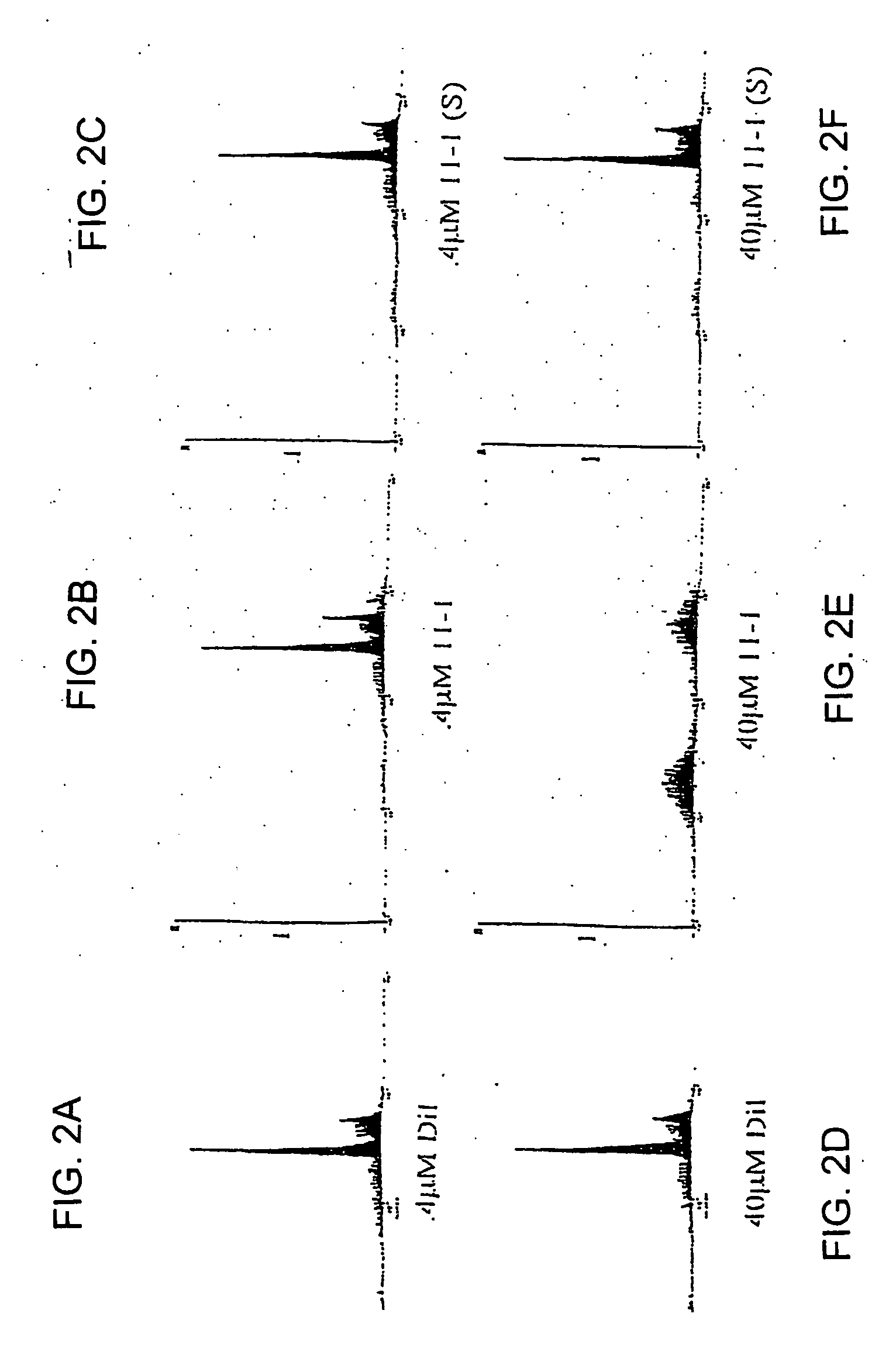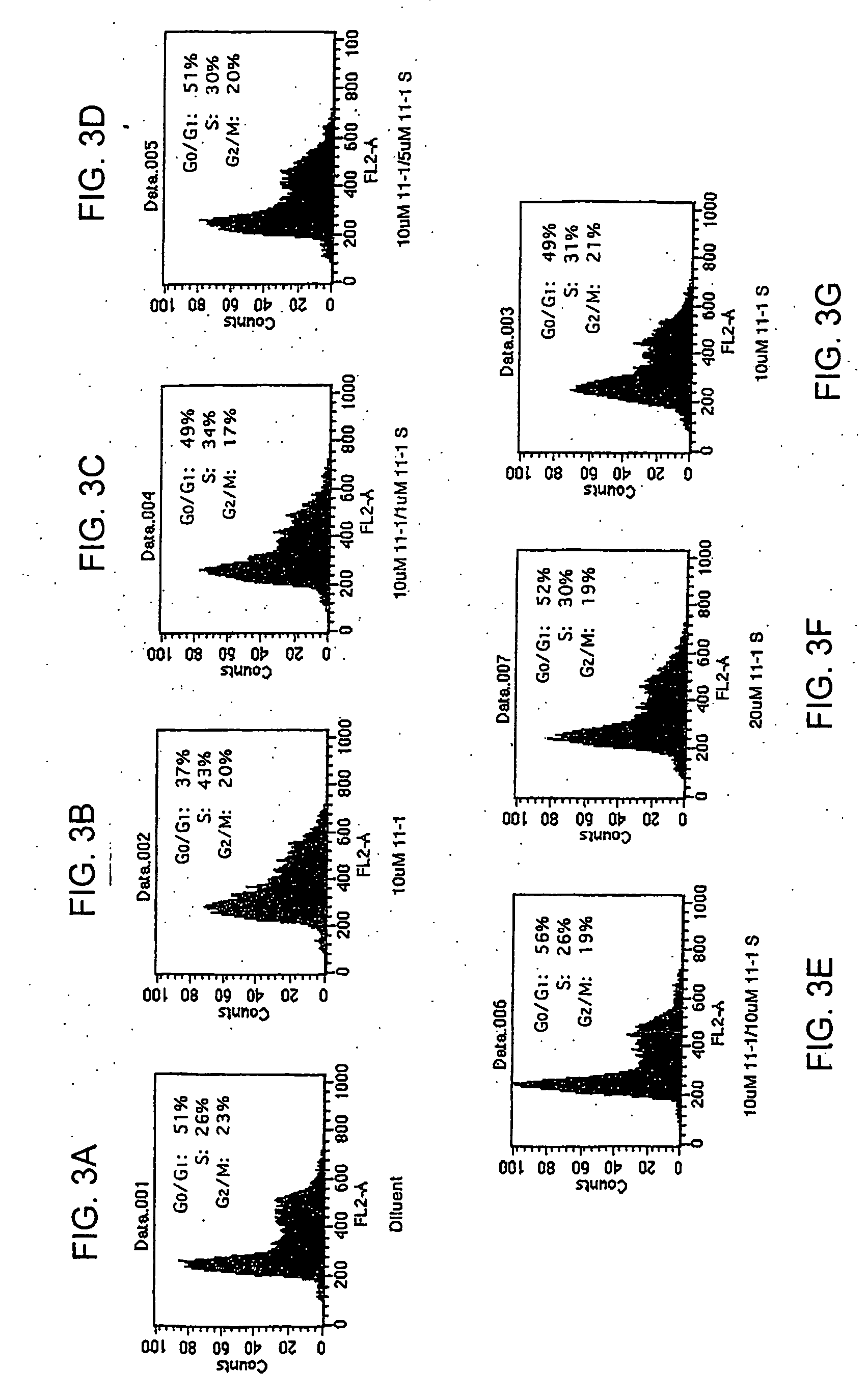Modulation of telomere-initiated cell signaling
- Summary
- Abstract
- Description
- Claims
- Application Information
AI Technical Summary
Benefits of technology
Problems solved by technology
Method used
Image
Examples
example 1
Oligonucleotides can Induce Apoptosis
[0102] Oligonucleotides homologous to the telomere overhang repeat sequence (TTAGGG; SEQ ID NO: 1), sequence (11mer-1: pGTTAGGGTTAG; SEQ ID NO: 2), complementary to this sequence (11mer-2: pCTAACCCTAAC; SEQ ID NO: 3) and unrelated to the telomere sequence (11mer-3: pGATCGATCGAT; SEQ ID NO: 4) were added to cultures of Jurkat cells, a line of human T cells reported to undergo apoptosis in response to telomere disruption. Within′ 48 hours, 50% of the cells treated with 40 μM of SEQ ID NO: 5 had accumulated in the S phase, compared to 25-30% for control cells (p0 / G1 DNA content, compared to 2-3% of controls (p<0.007, non-paired t-test; see FIGS. 1E-1H). At 96 hours, 20±3% of the 11mer-1 treated cells were apoptotic compared with 3-5% of controls (p<0.0001, non-paired t-test). To exclude preferential uptake of the 11mer-1 as an explanation of its singular effects, Jurkat cells were treated with oligonucleotides labeled on the 3′ end with fluorescein...
example 2
Phosphorothioate Version of the Telomere Overhang Homolog 11mer-1 Does Not Induce Apoptosis
[0103] Cultures of Jurkat human T cells were treated with either diluent, 11mer-1 (SEQ ID NO: 1) or the phosphorothioate 11mer-1 (11mer-1-S) for 96 hours, then collected and processed for FACS analysis. Two concentrations of the oligonucleotides were tested, 0.4 μM (FIGS. 2A-2C) and 40 μM (FIGS. 2D-2F). At 0.4 μM, neither of the oligonucleotides affected the expected exponentially growing cell cycle profile of the Jurkat cells. At 40 μM, the 11-mer-1 induced extensive apoptosis, indicated by a sub-G0 / G1 peak, while the 11mer-1-S had no effect.
example 3
Phosphorothioate Version of 11mer-1 Blocks Induction of S-Phase Arrest by the Phosphate Backbone 11mer-1
[0104] Cultures of a keratinocyte cell line (SSC12F, 100,000 cells / 38 cm2) were treated for 48 hours with only the 11mer-1 (SEQ ID NO: 2) or with the 11mer-1 in the presence of increasing concentrations of the 11mer-1-S. As shown previously in Example 1, the 11mer-1 induced an S-phase arrest as demonstrated by FACS (Becton-Dickinson FacScan). Forty-three percent of the cells were in the S phase, compared to 26% of the control, diluent-treated cells. However, when increasing concentrations of the phosphorothioate 11mer-1 were also added to these cultures, fewer cells became arrested (FIGS. 3A-3G). Complete inhibition of this arrest was seen with a ratio of 11mer-1: 11mer-1-S of 2:1. The 11mer-1-S by itself did not induce the S-phase arrest.
PUM
| Property | Measurement | Unit |
|---|---|---|
| Fraction | aaaaa | aaaaa |
| Absorbance | aaaaa | aaaaa |
| Morphology | aaaaa | aaaaa |
Abstract
Description
Claims
Application Information
 Login to View More
Login to View More - R&D
- Intellectual Property
- Life Sciences
- Materials
- Tech Scout
- Unparalleled Data Quality
- Higher Quality Content
- 60% Fewer Hallucinations
Browse by: Latest US Patents, China's latest patents, Technical Efficacy Thesaurus, Application Domain, Technology Topic, Popular Technical Reports.
© 2025 PatSnap. All rights reserved.Legal|Privacy policy|Modern Slavery Act Transparency Statement|Sitemap|About US| Contact US: help@patsnap.com



